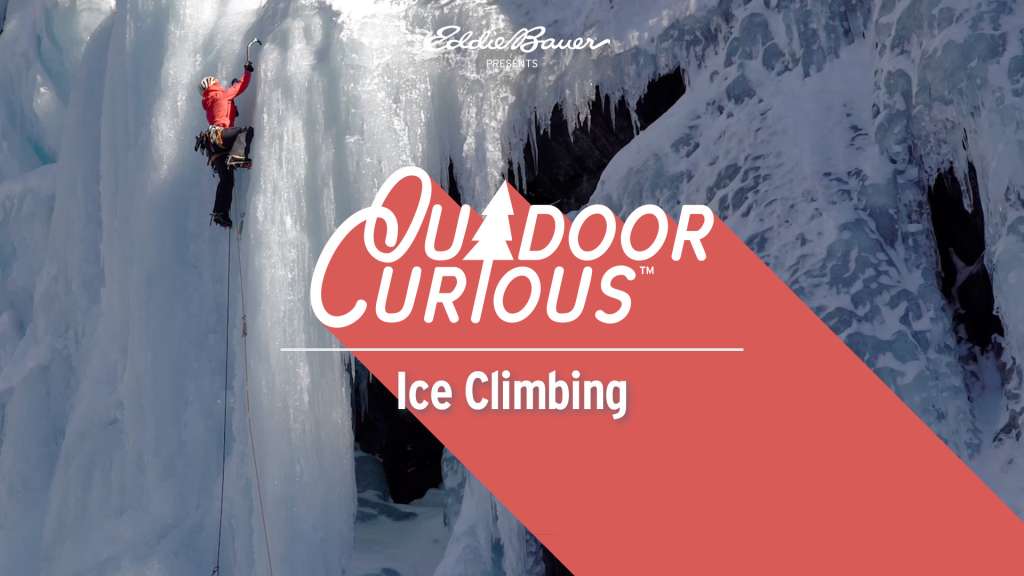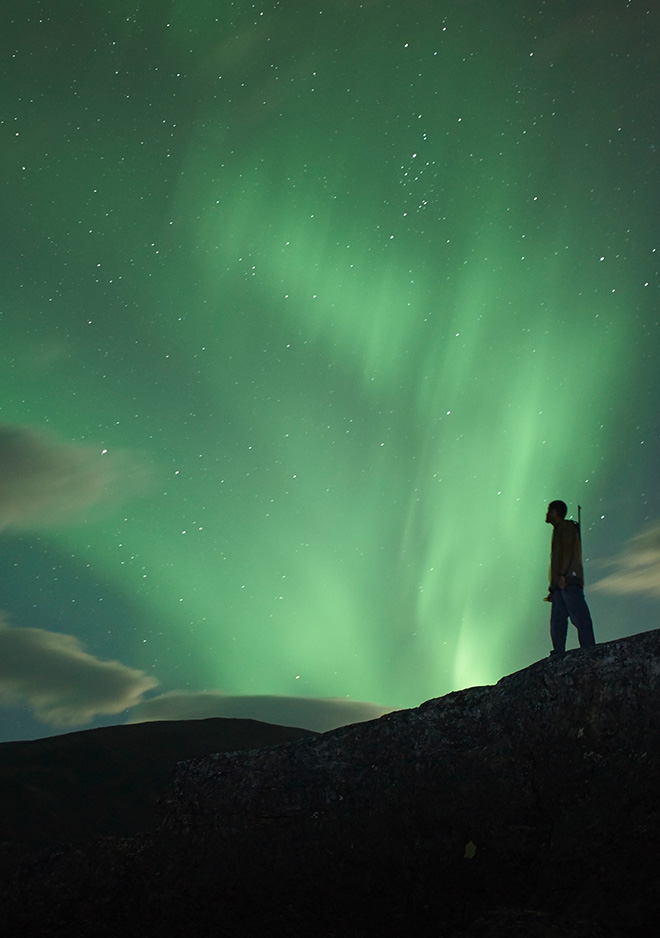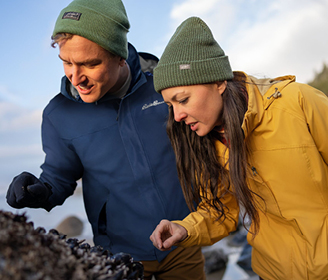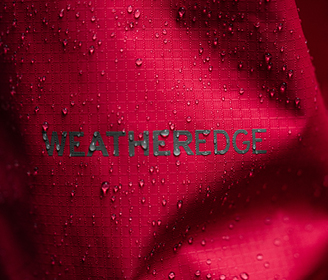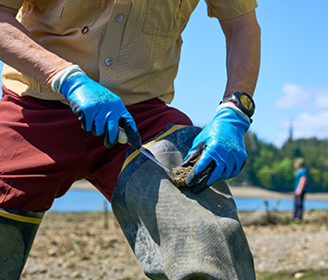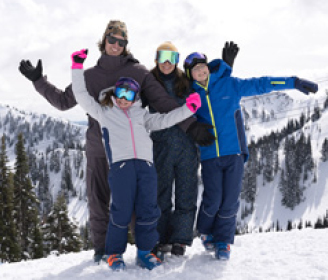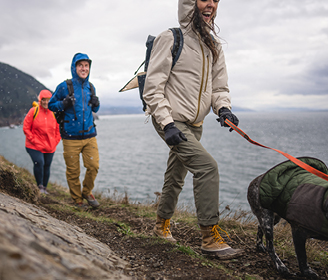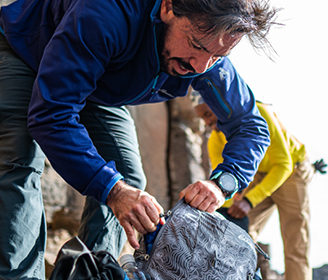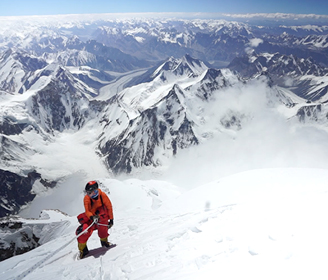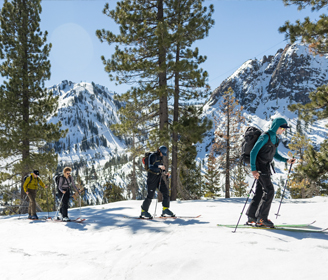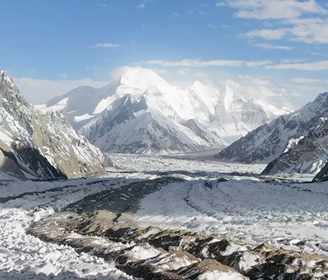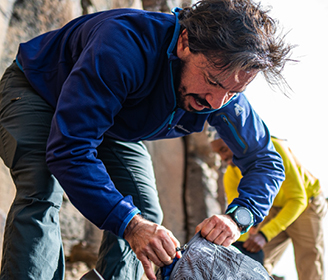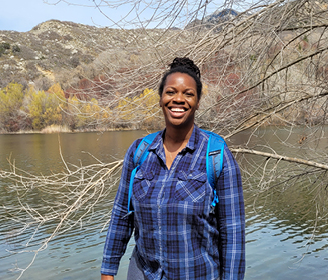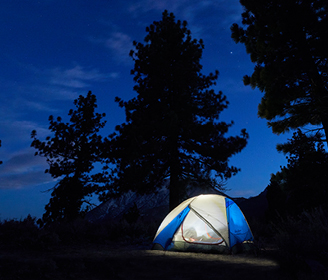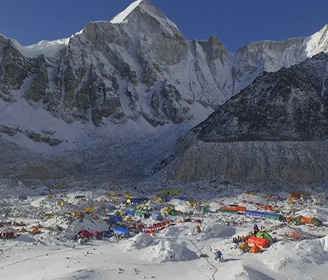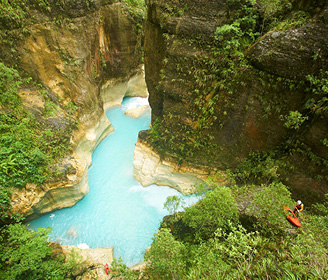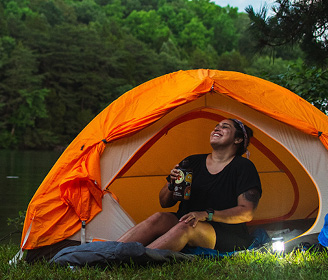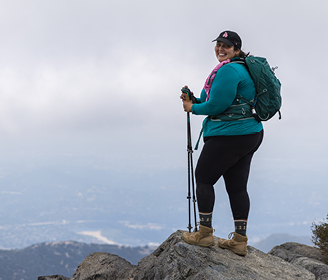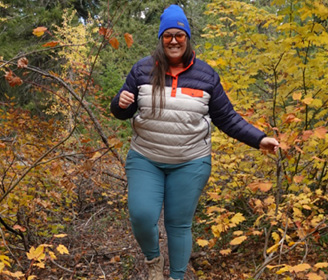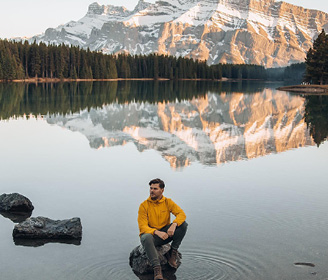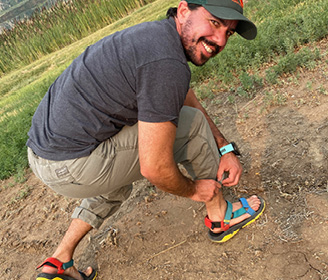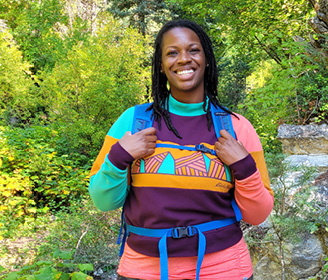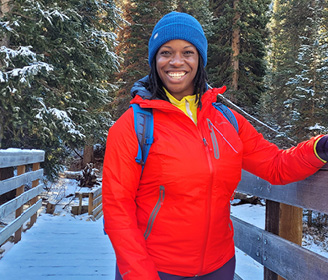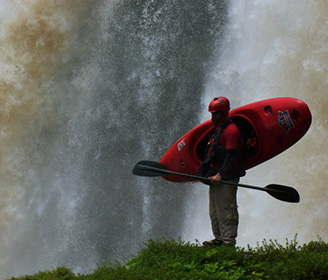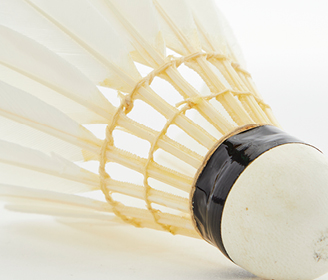Want to know what the ‘screaming barfies’ are? Or how ice axes are rated? Eddie Bauer alpine climbing guide Caroline George tackled some of the hardest ice and mixed routes, from the Alps and Ouray to Norway, Iceland, and the Canadian Rockies, as well as competing in the Ice Climbing World Cup. She’s here to answer the internet’s most asked questions about ice climbing.
00:39 – What gear do I need to ice climb?
The basic gear you’ll need head to toe, a helmet, ice axes for your hands, a harness and crampons and stiff boots that you can fit your crampons to. So that’s the basic gear that you need. You’ll also need a belay device to belay your partner, and if you’re a leader you’re gonna need more gear. So you’ll need a whole set of ice screws, minimum 10 ice screws, and some clip dress to clip into the ice crews, a double set of ropes, if you’re gonna do multi-pitch roots so you can wrap down the roots and a single rope if you’re gonna go do top rope climbing for in a park. For clothing, you’re gonna need some warm clothes. So a nice hat that’s gonna cover your ear. That’s really important and that doesn’t wobble too much under your helmet. Some warm clothing on the bottom as well as dry gear. So a hard shell for the top and for the bottom and a really big down belay parka to stay warm while you’re belaying your partner or hanging out in the park.
01:40 – Do I need to know how to rock climb before ice climbing?
You do not need to know how to rock climb before you ice climb. A lot of the skills that you’ll learn rock climbing for body movements, you can replicate ice climbing. And if you can really replicate the skills from rock climbing into ice climbing, ice climbing will be a lot easier and a lot more intuitive but you can learn ice climbing without knowing how to rock climb.
02:04 – What kind of ice is best for ice climbing?
The colder the temperature, the more stress is in the ice and so when you swing your tool in the ice you might get like a really big fracture through the ice. So cold temperature is not so great. Really warm temperature when the ice is too wet is also not that great because the protection you’ll put it in the ice won’t be so solid. What’s really important to note though is the worst for the ice is a very big shift in temperature overnight. So if you go from warm ice to suddenly very cold temperatures, this is gonna create massive stress in the ice.
02:44 – Is ice climbing dangerous?
For sure, ice climbing can be dangerous. We see ice climbing as a sport where falling is forbidden. So your surrounding can also be dangerous ice climbing as well as your gear and as well as ice as the medium. So you really have to be aware of your surroundings and knowledgeable about the risks that you’re facing to mitigate.
03:08 – What are the different types of ice axes and how are they rated?
There are two ratings for ice axes in the market. There’s a T-rating and a B-rating. T-rating is for technical ice axes and B-rating is for basic ice axe. I have a basic ice axe Schlumpf from Blue Ice. These ice axes are more for like snow travel when you’re skiing drawing in the wintertime. And so these are not rated for ice climbing. And then we have technical tools. This is the Ergonomic from Petzl and on the shafts you will see that it is written a T. These tools are rated for ice climbing and are a lot more sturdy and strong. So a T-rated tool will be a lot more versatile than a B-rated tool.
03:52 – What should I look for in an ice climbing ice axe?
I look for an ice axe that has a good handle so that my knuckles are really well protected. On this ice axe you can see that when I grab it, between this and this my hand is completely protected from the wall. So I can swing into the ice and my hand is not banging against the ice. And also the bulge clears all the bulges in the ice. So that’s also a really nice feature so that if you’re climbing steep ice with ice bulges, your ice axes doesn’t bounce off of the ice. There’s different types of ice axes on the market and so I would refer to specialist and see exactly what you wanna do.
04:36 – What kind of crampons are used for ice climbing?
For climbing we’re looking for technical crampons that have sharp serrated points. So they have teeth so that the crampon doesn’t slide out of the ice. There’s different types of crampons and I personally like a mono-points, so it’s just a one point in the front so that I can use my crampon edging with this point and the site point or this point and the other site point so that it works a little bit like a rock climbing shoe. It’s a little bit the same. There’s a point on the rock climbing shoe and for me that’s the mono-point and that I can use the edges to balance myself off of the ice. What I think is important in crampons is to have a plate underneath so it allows your snow travel sometimes to access the climbs. You need to climb up some snow and so if you, it balls up when you come down from the climb and the snow is warmed up, it can be almost a hazard. So I like to have these plates.
05:39 – Does it have to be below freezing outside to ice climb?
Early season when the ice is still forming, it’s really important that it is freezing outside to go ice climbing so the ice is really well frozen. Once the ice has been freezing for a couple months, throughout the winter time, sometimes you can go ice climbing and it’s not fully freezing outside and it can be actually pleasant to climb on a warmer day when it’s actually not completely freezing. Until you really know how it works, it’s better to ask a professional.
06:09 – What does reading ice mean?
Reading the ice means to look at the ice and to see the features where it is good to anchor your ice tool. So, for example, if you are trying to anchor your ice axe in a bulge, so something that is round shaped like this, in any round shape there is tension. If you make a fist, you can see that your skin is stretching over your knuckles. A bulge creates tension and it’s an area where a bulge is more likely to release. When we read the ice we like to look for divots in the ice, natural features, that we can tap into and because it is a divot, there isn’t that tension and so it’ll be easier to anchor the tool and also there’s less chance of the ice fracturing in that spot. Another way to read the ice, would be to understand if the ice is too cold or not too cold, if there’s fractures that have occurred and to understand how safe the ice is.
07:06 – Are glaciers and crevasses equally good as waterfalls to start ice climbing?
I would say it’s not the best place to start ice climbing. Sometimes the ice can be really old on glaciers and almost impossible to climb on because it’s too hard. So it depends where the glacier is or what the temperature is, what the season is. But I know that in the summertime a lot of people go ice climbing on glaciers to train. So if you find somewhere that is safe and that, you know it’s safe to climb on it’s a glacier, it’s good but I think it requires different skills and pure ice climbing.
07:44 – What is a successful ice screw placement?
It’s when you place the ice screw perpendicular to the ice and when I place it, then there’s a carrot. We call it carrot that comes straight out of the cone here. And if it is completely continuous, then it means the ice screw replacement is good.
08:05 – Why are ice screws hollow?
The ice screws are hollow so that you go into the ice and it fits bigger surface of the ice and it gives more support in the ice for the ice screw to hold.
08:21 – What are the most common mistakes that lead to falling?
Ice axe and crampon placements will define your confidence on the ice. If you swing your ice axe in the ice and you feel like it’s not good, likely the next swing you’ll make into the ice, won’t be that good. A lack of confidence leads to another lack of confidence. So when I try to swing my ice axe in the ice, I swing it mostly with my wrist and then once it’s anchored, I pull back on it. If there’s resistance, I know my ice axe is in the ice properly and then I can move on from that to the next tool. Another common mistake that people make that can lead to falling is that, people often kick their feet in the ice facing down. We wanna kick our crampons into the ice as if we’re kicking a soccer ball. So we’re kicking upward. By kicking my crampon upward, as you can see these teeth bites into the ice and settle on the ice as well. So with my heel down, I have more pressure on the ice and more stability than if I’m just on my front point and then I’m really unstable and the front comes out.
09:33 – How do I manage body heat when ice climbing?
Starting with a base layer that is dry and warm, preferably wool, will keep you quite a bit warmer even if you get a bit wet. A wool shirt, a thin down jacket and then a hard shell. I’ll climb with that and when I get to the anchor, I’ll layer up so it might be one more thin down jacket. When I’m climbing I have thin gloves on because they provide me more dexterity. Inside my jacket pockets, I always always have a warm pair of glove that I carry with me so that when I get to the anchor I can switch to warmer gloves. My legs, I have typically a really warm base layer and then I have a hard gel on top of this. And usually not more if it’s really, really cool then I’ll add tights. I also like to wear a neck gaiter to keep my neck warm because a lot of the heat comes out from that.
10:30 – What are screaming barfies?
When you’re climbing your hands are above your head. So the blood goes down, comes outta your hands and so you’re not really getting good circulation in your hand. And when they come back down then the blood comes rushing back in and it feels like your flesh is gonna explode out of your skin ’cause it seems so dense in there and it makes it really, really painful. I get screaming barfies pretty much every pitch. I don’t have like the best circulation in my hands so I get them a lot. Some people pass out even from them and sometimes it makes them wanna vomit and they makes them wanna scream too. So hence the screaming barfies.
11:11 – How do I descend down ice walls?
If you’re doing a multi-pitch root, you will repel down the wall like you would repel down a rock face. So if there’s fixed anchors, then you’re repelling down on the fixed anchors. You’ll thread your double ropes through the anchor. I use an overhand knot with the two ropes and then I just repel like that. Sometimes on ice climbs there aren’t fixed anchors and you have to make them yourself.
11:44 – What’s the reason for using an A-thread versus a V-thread anchor?
A V-thread is when we screw into the wall horizontally, an A-thread is when we screw into the wall vertically. What matters is the quality of the ice and the ease of making the anchor. So there’s not that much of a difference. Both have similar ratings, for strength. It’s generally your preference and you should try and practice with both so you’re used to doing either or.
12:15 – What do I do with the placements when I am not happy with them?
So when I’m not happy with the placements, I will pull my ice axe out and try to re-anchor it better. If there’s a huge plate that came around my placement because of the tension in the ice, I will break that plates and remove the broken ice and then go behind and once I’ve cleared all the ice then I will try to replace my ice axe. If that’s not possible, I also will try to place my tool somewhere else. And it’s the same with an ice replacement. If I place my ice crew and I don’t like the quality of the ice, then I will try to find a better place for my ice crew.
12:57 – What does controlling the pump mean?
Pump is when you are holding onto something and suddenly your forearm starts burning from the lactates. A very key safety point for ice climbing is knowing how to rest on your ice axes to get rid of the pump. So shaking out one hand on a tool, then switching hands and once you feel like you’ve recovered enough then you keep going.
13:21 – How do I find ice climbing partners?
Learning with a professional in a course setting will enable you to meet people who are like-minded and I would say that’s the best way to go about it.
13:31 – Are dual-points or mono-points more effective in steep ice?
Personally, I only climb with mono-points in steep ice. I find ways around the issues that provides. I think it’s just a matter of preference.
13:46 – What are good ice climbing snacks?
I think in the mountains, the snacks that are good are the ones that you don’t get tired of and that don’t make you sick. In the wintertime, I really like to drink broth that I’ve made myself with cook bones and vegetables. It’s warm, it’s easily digested and it has good calories. I think for ice climbing snacks that are a little bit hardy like good cookies that you might like that are healthy will go nicely with a cup of tea on an ice climb.
14:17 – How to rest partway up climb?
It is important when ice climbing to know how to find stability on both your feet and to able to shake out on your tool. So if you form a perfect triangle underneath your ice axe, it’s easy to switch hands on your ice axe and recover that way. So this will get rid of the pump, it will rewarm your hands and it will enable you to rest as well. It is also possible to place an ice screw and clip into it to rest and recover.
14:50 – What has been your favorite ice climbing experience?
This one that I did with the friends in Norway where we tried this climb, there was 700 meters and hadn’t been climbed that year so there was no hooks, nothing in place. And it was pretty hard with like this overhanging roof you had to come out of and coming out of the roof the whole climb was cracked through and through. And so, there was a lot of fear in that, but then you have to go back to your mind and think, well the conditions are stable, the temperatures are stable. It cracked but now it seems like really stable again. We made it to the top and then we knew we would wrap down in the dark where there’s no fixed anchor or anything and so we had to fully rely on our knowledge and experience to make it down safely in the dark. It’s quite the reward especially with such challenging conditions and being alone all alone there. That was pretty magical with the, yeah the Arctic setting sun. That was like a really special moment.

CAROLINE GEORGE
Alpine Climbing Guide (IFMGA)
For more than a decade, Caroline George has lived for the vertical dimension, tackling some of the hardest ice and mixed routes. Raised by climbing parents, George followed in their footsteps by sharpening her skills in the Swiss Alps, then earned her guiding certs in the male-dominated ranks in a profession steeped in alpine tradition. A true working guide, she has also participated in an impressive tick list of climbing expeditions that have taken her from Mt. Vinson, Antarctica, to the deeply carved fjords of Norway.

